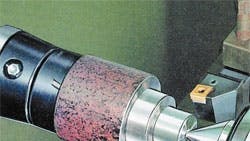Computer simulations put bearings to the test
Bearings are one of the most important components in a motion system. They’re also one of the most anonymous; and that’s by design. When bearings need attention, there’s usually a problem.
The time to pay attention to bearings is before they go into an application, not after. But what do you do when bearings with the proper dimensions and tolerances don’t measure up in service? This all-too-frequent situation prompted researchers at SKF to break out one of the most potent analytical tools available for dynamic systems today — computer simulations.
Using computers and a dynamic modeling tool called Orpheus, SKF engineers opened a window into the secret life of bearings. By simulating application conditions along with the bearing itself, they found they could account for the critical interactions between machine components that ultimately affect bearing life and performance.
Originally developed to analyze machine vibrations, Orpheus is an excellent tool to study the accuracy (runout) of bearing-spindle arrangements, accounting for elastic deformation in shafts, housings, and bearing rings, and the dynamic effects of highspeed rotation. It also accounts for internal bearing geometry, loading conditions, clearance, preload, raceway waviness and runout, mounting errors, inaccuracies of housing bore and shaft seating, and various interactions between bearings and other components.
SKF engineers put Orpheus to the test, looking at the dynamics of a real-life revolving tailstock center. The prototype, manufactured by Röhm, an SKF customer, is an interchangeable lathe insert that lets machinists turn work pieces over their entire length without reclamping. The radial runout of the rotating center tip must be less than 5 μm, placing extreme importance on bearing accuracy.
The computer model of the rotating spindle consists of a flexible shaft supported by several bearings; a double-row angular-contact ball bearing, a thrust ball bearing, and a needle roller bearing. The bearing- shaft arrangement is rather complex and statically indeterminate, thus the use of simulation.
To get a clear picture of how bearing quality and mounting errors affect accuracy, SKF engineers calculated and plotted the orbit of the rotating shaft tip based on shaft and bearing ring ovality, raceway runout, waviness of raceways and balls, ball diameter spread, raceway co-axiality, ring misalignment, and preload. An advanced built-in solver minimized CPU time, computing each shaft orbit in less than one minute.
The study showed that shaft runout is primarily a function of the interaction between the angular-contact and thrust bearings. This is to be expected because the inner ring face of the angular-contact bearing is perpendicular to the thrust bearing, imparting a maximum load.
Another interesting find, based on vibration calculations, helped SKF engineers better understand manufacturing tolerances for bearing components, and how to best test them in production. In the computer simulation, rolling elements are rolled across the complex surface of a deformed and wavy raceway. In addition, bearing rings are allowed to flex, clearly exposing the relationship between shaft vibration and bearing quality.
